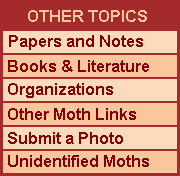.jpg)

This is a book that every student, collector and photographer of western moths will need, want and cherish. It is not only a beautiful book, a testament to the capabilities of University of California Press, it is a fitting monument to the careers of two fine lepidopteran scientists who bring to this work their combined 100 years of research and teaching experience.
This is not a field guide. It is a hefty hardcover book, 8-1/2 x 11 inches, with 64 beautifully printed full-color plates. About 370 pages are devoted to text, glossary and index, with another 130 pages for plates and facing caption pages. Fifty-eight of the plates display photographs of almost 2,350 specimens, and about 2,050 species. It is remarkable that 26 of the plates are given over to micromoths of about 1,075 species. This degree of attention to the micros, among which both authors have devoted much time, is by itself a tremendous contribution to the literature. Six plates depict mainly living larvae, but also adults and elements of life cycles such as leaf mines, tents and the like.
Sprinkled throughout the text are about 250 line drawings, mainly of the genitalia of exemplar species, giving an overview of the families and subfamilies. Where appropriate the authors also draw attention to defining characters of genitalia in the text, but this is not so extensive as to make reading difficult or uninteresting to the layman. Quite to the contrary, the text is relatively free of technical jargon and the stilted language of field guides where words and space may be considered to be at a premium. The writing in this book approaches that of delightful prose. Whether you are reading beside the living room hearth, in front of a field site campfire, or in a tiny cubicle at the lab, you are in for an enjoyable read.
Both authors have been involved in describing new species for many years. I can find 144 instances where one or the other has authored or coauthored a new species description, or has had a species named in his honor. A very special case of honorific was William E. Miller's naming, in 1995, a new Tortricid genus Jerapowellia. Although the species Jerapowellia burnsorum is known from Arizona and New Mexico, it was not selected for inclusion in this book. Of the 144 species just mentioned, 54 can be found in this volume including Adela oplerella, described by Powell in 1969; Coptodisca powellella, described by Opler in 1971; Decodes opleri, described by Powell in 1980. The earliest Powell honorific that I can find is Gyros powelli by Munroe in 1959, and the most recent is Pelochrista powelli by Wright in 2005. For Opler the earliest honorific is Adela oplerella, mentioned above, while the most recent is Sympistis opleri by Troubridge in 2008.
Sympistis brings to attention a minor problem encountered in this book, indeed in almost all books and monographs dealing with species. Taxonomic changes are part of the lifeblood of science and are made without respect for book publishing schedules. Thus, while a book such as this one is in preparation or in the press, name changes are occurring that simply cannot be reflected in the soon-to-appear volume. While this book was in the press Jim Troubridge's revision of Oncocnemidinae was published in ZooTaxa in October, 2008. In that paper Troubridge described 50 new species including Sympistis opleri. He also moved from Oncocnemis into Sympistis four species covered in MWNA but which remain under the old name in this volume. There are a number of other cases of old names in this work. Perhaps these and other minor corrections can be made in future printings.
I do have one criticism that I feel is more than just a little quibble. On the caption pages facing the plates there are no instructions to the reader as to the page where text for a given species may be found. This has been a standard feature of every MONA Fascicle (but annoyingly missing from Tuttle's recent volume on Sphingidae) and should have been included in this work. Due to this omission, readers must first go to the index to find a page number for the species of interest. Correcting this problem should be a priority in future printings.
It would be very nice if University of California Press could produce a slender volume or booklet containing just the plates and their caption pages. I know that I will rather quickly wear out my copy of the book through extensive daily use of the plates.
The authors and UCP are to be congratulated and applauded for a very fine and worthwhile book. ~ Bob Patterson



.jpg)

.gif)